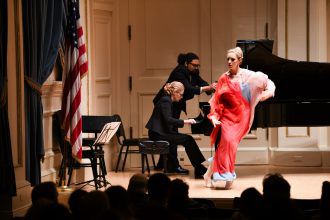 Gabrielle Armenier’s early experiences with Eurythmy as a young active violinist freed her from a thorny relationship with her instrument and resulting stage fright. “Eurythmy taught me not to hold on to my body, to my instrument, but to anchor my gestures in space. It turned a most often confrontational relationship to space into an intrinsic one” she said during our February interview following her Sol-Etudes program at Carnegie’s Weill Recital Hall. This repertoire will be featured again in Napa on April 27th.
Gabrielle Armenier’s early experiences with Eurythmy as a young active violinist freed her from a thorny relationship with her instrument and resulting stage fright. “Eurythmy taught me not to hold on to my body, to my instrument, but to anchor my gestures in space. It turned a most often confrontational relationship to space into an intrinsic one” she said during our February interview following her Sol-Etudes program at Carnegie’s Weill Recital Hall. This repertoire will be featured again in Napa on April 27th.
Armenier’s recital, spanning chamber and solo performances of works by Brahms, Ravel, Piazzolla, Wiprud, Auerbach, Gusev, and Stanhope, is based on the principals of Eurythmy formulated at the turn of the 20th century by Rudolf Steiner. Comprising Eurhythmy’s “tone,” “speech,” and “silent” aspects, Armenier’s Eurythmy performances explore human experience through a powerful recognition of informed movements. These sculpt space in time and reflect on artistic performance by visually enhancing our concept of sound production. The interdisciplinary approach lies at the root of an interactive discipline linking art, poetry, language, and music with the movements found at the base of all art forms.
“Tone eurythmy is choreographed directly from the elements of the score, but aims beyond its ‘mechanical translation’ by addressing the experience that arises when listening to music,” explains Armenier. “Eurythmy does not need music, music does not need eurythmy. But the reflection of one into the other opens up a different aspect of human experience.”
Different from other forms of movement performance such as ballet, Eurythmy does not employ the body as a tool for personal emotional expression. “In Eurythmy I don’t become the gesture, but rather I lend my body to a gesture. The audience is thus invited to become part of a gesture that is not solely my own. Movements relate to music by paying attention to the time element that lives between the notes and to the spatial one that lives in the phrase,” she explains. 
Facing the audience at all times overcomes a linear, one-dimensional approach to space. Eurythmy aims to enhance the quality of our perception of space, leading to a more connective and empowering experience. As it relates to the body, some of its principles overlap with those of the Alexander Technique. In how it unfolds in space, eurythmists move between two centers of gravity in constant interaction: one is the human heart, the other is the plane of infinity. These infinitely small and large points of reversal inform how you use the joints. “Joints have to be empty for the tone of a piano to resonate in. Or filled with a flowing movement for the sound of a violin,” Armenier explains.
For contemporary music, gestures are also choreographed according to elemental qualities. Polarities of darkness and light, cold and warmth, lightness and heaviness, or textures such as those of metal, wood, or wool play a role in how the gestures fit one with another. Colorful veils and flowing costumes additionally enhance the visual qualities of the movements. Eurythmy focuses not on the human body itself, but on its ability to sculpt the space around it.
The qualitative polarity of Goethe’s phrase “Music is liquid architecture, architecture frozen music” applies directly to Eurythmy, according to Armenier, in that “our gestures are derived from a close study of the human body in its relation to space; interval gestures come from the shape of the bones. The sculpting process that formed them is magnified to form the interval movements. The prime comes from the collarbone, the second from the humerus, the major and minor thirds from the radius and the ulna, the fourth from the wrist, etc. Tone gestures on the other hand divide the space around the body into a radiant architecture.”
Eurythmy produces a performing experience unlike many others; it lures you in to new shores, perhaps a bit like the song of the sirens once captured Odysseus. Armenier’s confident and graceful movements ignite at least curiosity in the discipline, exploring the many mysterious and somewhat inexplicable layers of sound, space, and movement with a new artistic potential.
 Blogcritics The critical lens on today's culture & entertainment
Blogcritics The critical lens on today's culture & entertainment




